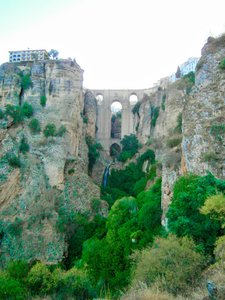Advertisement
Published: September 9th 2016

 The Building On The Left Is Where the Paseo de Heminway is Located
The Building On The Left Is Where the Paseo de Heminway is Located
They para-glide from there now. In 1936; Not so much. At least they didn't glide too far.The town of Ronda sits about 2 hours ride west of Granada. The journey is made half the way by bus and then by train. A new high speed rail is being built throughout Spain so occasionally you have to slum it by bus while the track beds are being remade.
We take a room at the Hotel Morales for 41 Euros a night. We've had better and we've had worse. The owner's name is Juan. He gives us a map of the town and some general directions.
Ronda's claim to fame is the invention of modern bull fighting. Hemingway and Orson Welles both hung out here. Hemingway was a bull fighter groupie and Welles was thinking of making a film version of 'The Man of La Mancha' here. But then he died.
Ronda is not a big town. You can walk everywhere. The town is perched on a 500-foot cliff. From the top the views of the rolling hills and the western mountains are amazing. We walk down the steep cliff face every morning via a cobbled zig-zag road. We pass beneath what is called the New Bridge though it was built in the
18th century. Towering archways and a fast moving stream passing beneath them. Before we start the taxing slog back up we stop and eat a breakfast picnic on a small bridge over a deep-graveled trout stream. In the fields along the river healthy looking caballos prance around broad hay fields. We eat almonds from the trees along the road. It's that time of the year.
We take lunch at the Cafe Merced. Manuelo is the owner. He makes a very good ox-tail.
In the center of Ronda is an old cobble-stoned plaza fenced by 18th century buildings painted in yellow and white. It looks like a village in Mexico. A setting for 'A Fist Full of Dollars'. Souvenir shops sit along narrow lanes under bobbing rainbow canopies of Japanese lanterns. In the mornings here, you can catch a glass of cafe con leche and a thick slab of toast for a buck and a half.
There's a beautiful bull ring in Ronda. It is a museum piece. For 7-Euros you can walk through the horse training academy and the exhibits of Matador artifacts. The ring itself is a wide pancake of bright-yellow sand. They
fight bulls here for 2-weeks every year starting in the second week of September and the tickets are very hard to come by. It is the dream of every Spanish bull fighter to one day fight in Ronda. If they are ever deemed worthy.
There are pictures of Hemingway in the bars here. Behind the Parador Hotel is a small street named 'Paseo de Hemingway'. It is the spot where, in 1936 during the Spanish Civil war; a number of Fascists were executed when Nationalist peasants tossed them off the high Ronda cliff. The scene is recounted in chapter ten of 'For Whom The Bell Tolls'.
We find a good restaurant called 'La Farola' on a small barrio plaza. The benches are filled with three generations of families. The restaurants here do not open until 8 PM and things don't really get going until 9:30. We order some hard, rich cheeses and Spanish sausages to go with the glasses of ruby-red Rioja. We listen to the folks around us speaking in that lisping Andalucian Spanish we have grown accustomed to. Everyone is smiling. It is easy to smile in Ronda.
Advertisement
Tot: 0.079s; Tpl: 0.011s; cc: 11; qc: 27; dbt: 0.0573s; 1; m:domysql w:travelblog (10.17.0.13); sld: 2;
; mem: 1.1mb

 The Building On The Left Is Where the Paseo de Heminway is Located
The Building On The Left Is Where the Paseo de Heminway is Located